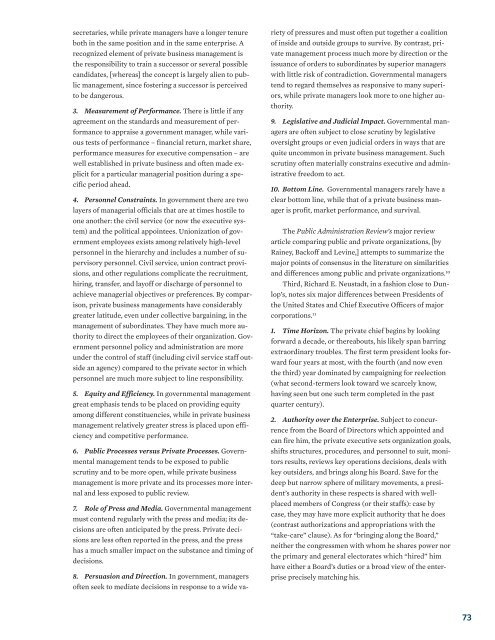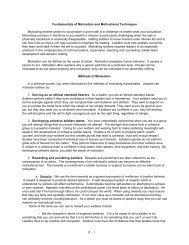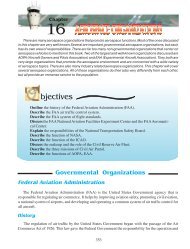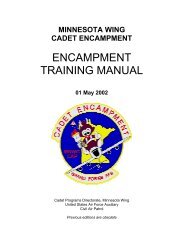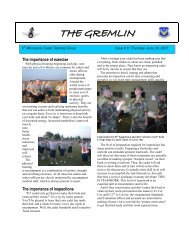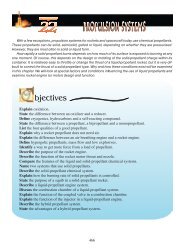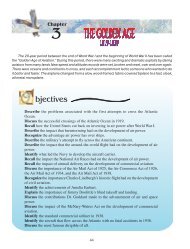TABLE 1:FUNCTIONS OF GENERAL MANAGEMENTStrategy1. Establishing objectives and priorities for the organization(on the basis of forecasts of the external environmentand the organization’s capacities).2. Devising operational plans to achieve these objectives.Managing Internal Components3. Organizing and staffing. In organizing the manager establishesstructure (units and positions with assigned authorityand responsibilities) and procedures forcoordinating activity and taking action. In staffing hetries to fit the right persons in the key jobs.*4. Directing personnel and the personnel management system.The capacity of the organization is embodied primarilyin its members and their skills and knowledge. Thepersonnel management system recruits, selects, socializes,trains, rewards, punishes, and exits the organization’shuman capital, which constitutes the organization’scapacity to act to achieve its goals and to respond to specificdirections from management.5. Controlling performance. Various management informationsystems – including operating and capital budgets,accounts, reports, and statistical systems, performanceappraisals, and product evaluation – assist managementin making decisions and in measuring progress towardsobjectives.Managing External Components6. Dealing with “external” units of the organization subjectto some common authority. Most general managers mustdeal with general managers of other units within thelarger organization – above, laterally, and below – toachieve their unit’s objectives.7. Dealing with independent organizations. Agencies fromother branches or levels of government, interest groups,and private enterprises that can importantly affect the organization’sability to achieve its objectives.8. Dealing with the press and the public whose action orapproval or acquiescence is required.*Organization and staffing are frequently separated insuch lists, but because of this interaction between thetwo, they are combined here. See Graham Allison andPeter Szanton, Remaking Foreign Policy (New York: BasicBooks, 1976), p. 14.DIFFERENCES: HOW ARE PUBLIC & PRIVATEMANAGEMENT DIFFERENT?While there is a level of generality at which managementis management, whether public or private, functions thatbear identical labels take on rather different meanings inpublic and private settings. As Larry Lynn has pointedout, one powerful piece of evidence in the debate betweenthose who emphasize “similarities” and those whounderline “differences” is the nearly unanimous conclusionof individuals who have been general managers inboth business and government. Consider the reflectionsof George Shultz (Secretary of State; former Director ofOMB, Secretary of Labor, Secretary of the Treasury, Presidentof Bechtel), Donald Rumsfeld (former congressman,Director of OEO, Director of the Cost of Living Council,White House Chief of Staff, and Secretary of Defense;now President of G. D. Searle and Company), MichaelBlumenthal (former Chairman and Chief Executive Officerof Bendix, Secretary of the Treasury, and now ViceChairman of Burroughs), Roy Ash (former President ofLitton Industries, Director of OMB; later President of Addressograph),Lyman Hamilton (former Budget Officer inBOB, High Commissioner of Okinawa, Division Chief inthe World Bank and President of ITT), and George Romney(former President of American Motors, Governor ofMichigan, and Secretary of Housing and Urban Development.)8 All judge public management different from privatemanagement – and harder!Orthogonal Lists of DifferencesMy review of these recollections, as well as thethoughts or academics, has identified three interesting,orthogonal lists that summarize the current state of thefield: one by John Dunlop; one major Public AdministrationReview survey of the literature comparing public andprivate organizations by Hal Rainey, Robert Backoff andCharles Levine; and one by Richard E. Neustadt, preparedfor the National Academy of Public Administration’sPanel on Presidential Management.John T. Dunlop’s “impressionistic comparison of governmentmanagement and private business” yields thefollowing contrasts. 91. Time Perspective. Government managers tend tohave relatively short time horizons dictated by politicalnecessities and the political calendar, while private managersappear to take a longer time perspective orientedtoward market developments, technological innovationand investment, and organization building.2. Duration. The length of service of politically appointedtop government managers is relatively short, averagingno more than 18 months recently for assistant72
secretaries, while private managers have a longer tenureboth in the same position and in the same enterprise. Arecognized element of private business management isthe responsibility to train a successor or several possiblecandidates, [whereas] the concept is largely alien to publicmanagement, since fostering a successor is perceivedto be dangerous.3. Measurement of Performance. There is little if anyagreement on the standards and measurement of performanceto appraise a government manager, while varioustests of performance – financial return, market share,performance measures for executive compensation – arewell established in private business and often made explicitfor a particular managerial position during a specificperiod ahead.4. Personnel Constraints. In government there are twolayers of managerial officials that are at times hostile toone another: the civil service (or now the executive system)and the political appointees. Unionization of governmentemployees exists among relatively high-levelpersonnel in the hierarchy and includes a number of supervisorypersonnel. <strong>Civil</strong> service, union contract provisions,and other regulations complicate the recruitment,hiring, transfer, and layoff or discharge of personnel toachieve managerial objectives or preferences. By comparison,private business managements have considerablygreater latitude, even under collective bargaining, in themanagement of subordinates. They have much more authorityto direct the employees of their organization. Governmentpersonnel policy and administration are moreunder the control of staff (including civil service staff outsidean agency) compared to the private sector in whichpersonnel are much more subject to line responsibility.5. Equity and Efficiency. In governmental managementgreat emphasis tends to be placed on providing equityamong different constituencies, while in private businessmanagement relatively greater stress is placed upon efficiencyand competitive performance.6. Public Processes versus Private Processes. Governmentalmanagement tends to be exposed to publicscrutiny and to be more open, while private businessmanagement is more private and its processes more internaland less exposed to public review.7. Role of Press and Media. Governmental managementmust contend regularly with the press and media; its decisionsare often anticipated by the press. Private decisionsare less often reported in the press, and the presshas a much smaller impact on the substance and timing ofdecisions.8. Persuasion and Direction. In government, managersoften seek to mediate decisions in response to a wide varietyof pressures and must often put together a coalitionof inside and outside groups to survive. By contrast, privatemanagement process much more by direction or theissuance of orders to subordinates by superior managerswith little risk of contradiction. Governmental managerstend to regard themselves as responsive to many superiors,while private managers look more to one higher authority.9. Legislative and Judicial Impact. Governmental managersare often subject to close scrutiny by legislativeoversight groups or even judicial orders in ways that arequite uncommon in private business management. Suchscrutiny often materially constrains executive and administrativefreedom to act.10. Bottom Line. Governmental managers rarely have aclear bottom line, while that of a private business manageris profit, market performance, and survival.The Public Administration Review’s major reviewarticle comparing public and private organizations, [byRainey, Backoff and Levine,] attempts to summarize themajor points of consensus in the literature on similaritiesand differences among public and private organizations. 10Third, Richard E. Neustadt, in a fashion close to Dunlop’s,notes six major differences between Presidents ofthe United States and Chief Executive Officers of majorcorporations. 111. Time Horizon. The private chief begins by lookingforward a decade, or thereabouts, his likely span barringextraordinary troubles. The first term president looks forwardfour years at most, with the fourth (and now eventhe third) year dominated by campaigning for reelection(what second-termers look toward we scarcely know,having seen but one such term completed in the pastquarter century).2. Authority over the Enterprise. Subject to concurrencefrom the Board of Directors which appointed andcan fire him, the private executive sets organization goals,shifts structures, procedures, and personnel to suit, monitorsresults, reviews key operations decisions, deals withkey outsiders, and brings along his Board. Save for thedeep but narrow sphere of military movements, a president’sauthority in these respects is shared with wellplacedmembers of Congress (or their staffs): case bycase, they may have more explicit authority that he does(contrast authorizations and appropriations with the“take-care” clause). As for “bringing along the Board,”neither the congressmen with whom he shares power northe primary and general electorates which “hired” himhave either a Board’s duties or a broad view of the enterpriseprecisely matching his.73
- Page 1 and 2:
VOLUME FOUR STRATEGIC PERSPECTIVESL
- Page 3 and 4:
VOLUME FOUR STRATEGIC PERSPECTIVESL
- Page 5 and 6:
VOLUME FOUR STRATEGIC PERSPECTIVESL
- Page 7:
VOLUME FOUR STRATEGIC PERSPECTIVESL
- Page 10 and 11:
12CHAPTER 12INTRODUCTION TO STRATEG
- Page 12 and 13:
12.1 Strategic Leadership: Defining
- Page 14 and 15:
mandates or resolutions that would
- Page 16 and 17:
and ambiguity, aspiring strategic l
- Page 18 and 19:
12.2 National Security StrategyThe
- Page 20 and 21:
within our borders has always been
- Page 22 and 23:
front common challenges like violen
- Page 24 and 25: and our strategy, not sector earmar
- Page 26 and 27: thinking about organizations. She m
- Page 28 and 29: A systemic approach to failure is m
- Page 30 and 31: The late W. T. Grant Company is a r
- Page 32 and 33: the resources - setting the directi
- Page 34 and 35: focal point for describing and inte
- Page 36 and 37: Consequently, we do not restrict th
- Page 38 and 39: paragraphs, Web pages, then edit an
- Page 40 and 41: Web, can be viewed as a CS attempt
- Page 42 and 43: How to evaluate users and contribut
- Page 44 and 45: 13CHAPTER 13LEADING PUBLIC &VOLUNTE
- Page 46 and 47: 13.1 Leadership for Volunteers:The
- Page 48 and 49: 13.2 Take Root: Volunteer Managemen
- Page 50 and 51: QualificationsClearly list educatio
- Page 52 and 53: and effectively track their volunte
- Page 54 and 55: • Understand rules for recognitio
- Page 56 and 57: • Send a birthday card.• Submit
- Page 58 and 59: and tested more than six decades af
- Page 60 and 61: specific interests of the donors, v
- Page 62 and 63: tain) tax-exempt status from the In
- Page 64 and 65: Smucker, 1999).The Internal Revenue
- Page 66 and 67: culture is necessary to ensure the
- Page 68 and 69: 13.4 The New Look of TransparencyBy
- Page 70 and 71: ees for a couple of reasons: One, i
- Page 72 and 73: 13.5 Public and Private Management:
- Page 76 and 77: 3. Career System. The model corpora
- Page 78 and 79: islative charter - the Clean Air Ac
- Page 80 and 81: In controlling performance, Chapin
- Page 82 and 83: 14CHAPTER 14AIRPOWER ASSTRATEGIC LA
- Page 84 and 85: 14.1 Strategic Air Power: Fulfillme
- Page 86 and 87: carry it out. Their daylight raids
- Page 88 and 89: you did not rely on strategic bombi
- Page 90 and 91: 14.2 Warden and the Air Corps Tacti
- Page 92 and 93: ecomes one of applying sufficient i
- Page 94 and 95: tification, and a Jominian claim to
- Page 96 and 97: courage the rapid and widespread ex
- Page 98 and 99: it to influence physical players in
- Page 100 and 101: 14.4 Basic Air Force DoctrineAF Doc
- Page 102 and 103: earthquake-stricken Haiti. The worl
- Page 104 and 105: perspective. Airmen do not divide u
- Page 106 and 107: Command and ControlCommand and cont
- Page 108 and 109: 14.5 Should the US Maintain the Nuc
- Page 110 and 111: form of human government.” 20 Dem
- Page 112 and 113: obtainable goal. See the Global Zer
- Page 114 and 115: 15CHAPTER 15ORGANIZATIONAL CULTURE
- Page 116 and 117: 15.1 Organizational CultureBy Doria
- Page 118 and 119: Review. This action strives to unco
- Page 120 and 121: gram will serve and then having the
- Page 122 and 123: ticipating the changes being made b
- Page 124 and 125:
Many years of working with change p
- Page 126 and 127:
At the least, the areas of concern
- Page 128 and 129:
15.4 Developing an Innovative Cultu
- Page 130 and 131:
CONCLUDING THOUGHTSIn an ever-chang
- Page 132 and 133:
global issues. Businesses that poss
- Page 134 and 135:
— Sees the big picture—the shif
- Page 136 and 137:
16CHAPTER 16STRATEGIC COMMUNICATION
- Page 138 and 139:
16.1 Principles of Strategic Commun
- Page 140 and 141:
16.2 The Art of NegotiationBy Brend
- Page 142 and 143:
16.3 Negotiating Effectively Across
- Page 144 and 145:
hidden areas can act as cultural ho
- Page 146 and 147:
and four conflict styles. Hammer be
- Page 148 and 149:
maintaining the relationship. As th
- Page 150 and 151:
25 Mitchell R. Hammer, “Chapter 1
- Page 152 and 153:
tural, socioeconomic, and psycholog
- Page 154 and 155:
for the win-win," during which time
- Page 156 and 157:
interests and, at worst, as a gun s
- Page 158 and 159:
Public diplomacy is surely about mu
- Page 160 and 161:
But public diplomats do not have th
- Page 162 and 163:
Photo courtesy of the familyThe LEA
- Page 164:
THE CADET OATHI pledge that I will


